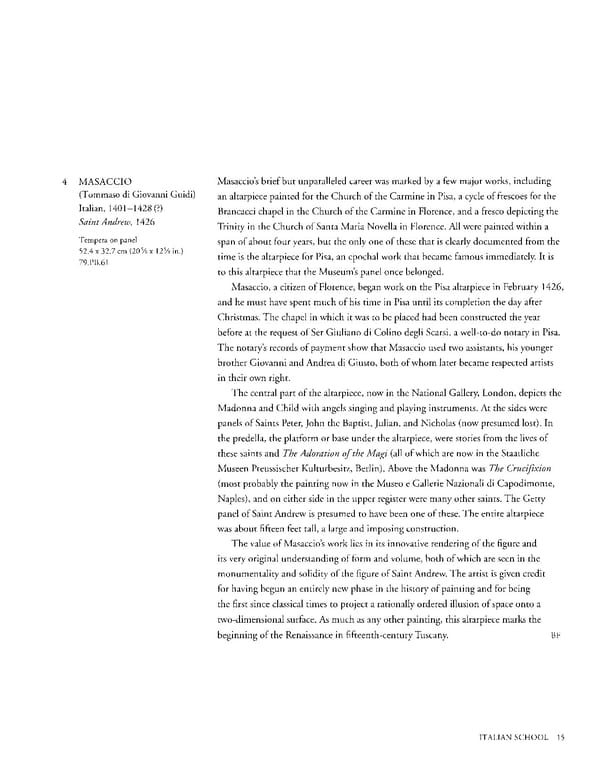4 MASACCIO Masaccio's brief but unparalleled career was marked by a few major works, including (Tommaso di Giovanni Guidi) an altarpiece painted for the Church of the Carmine in Pisa, a cycle of frescoes for the Italian, 14011428 (?) Brancacci chapel in the Church of the Carmine in Florence, and a fresco depicting the Saint Andrew, 1426 Trinity in the Church of Santa Maria Novella in Florence. All were painted within a Tempera on panel span of about four years, but the only one of these that is clearly documented from the 52.4 x 32.7 cm (20 x 12 in.) time is the altarpiece for Pisa, an epochal work that became famous immediately. It is 79.PB.61 to this altarpiece that the Museum's panel once belonged. Masaccio, a citizen of Florence, began work on the Pisa altarpiece in February 1426, and he must have spent much of his time in Pisa until its completion the day after Christmas. The chapel in which it was to be placed had been constructed the year before at the request of Ser Giuliano di Colino degli Scarsi, a welltodo notary in Pisa. The notary's records of payment show that Masaccio used two assistants, his younger brother Giovanni and Andrea di Giusto, both of whom later became respected artists in their own right. The central part of the altarpiece, now in the National Gallery, London, depicts the Madonna and Child with angels singing and playing instruments. At the sides were panels of Saints Peter, John the Baptist, Julian, and Nicholas (now presumed lost). In the predella, the platform or base under the altarpiece, were stories from the lives of these saints and The Adoration of the Magi (all of which are now in the Staatliche Museen Preussischer Kulturbesitz, Berlin). Above the Madonna was The Crucifixion (most probably the painting now in the Museo e Gallerie Nazionali di Capodimonte, Naples), and on either side in the upper register were many other saints. The Getty panel of Saint Andrew is presumed to have been one of these. The entire altarpiece was about fifteen feet tall, a large and imposing construction. The value of Masaccio's work lies in its innovative rendering of the figure and its very original understanding of form and volume, both of which are seen in the monumentality and solidity of the figure of Saint Andrew. The artist is given credit for having begun an entirely new phase in the history of painting and for being the first since classical times to project a rationally ordered illusion of space onto a twodimensional surface. As much as any other painting, this altarpiece marks the beginning of the Renaissance in fifteenthcentury Tuscany. BF ITALIAN SCHOOL 15
 Masterpieces of the Getty Museum: Paintings Page 15 Page 17
Masterpieces of the Getty Museum: Paintings Page 15 Page 17